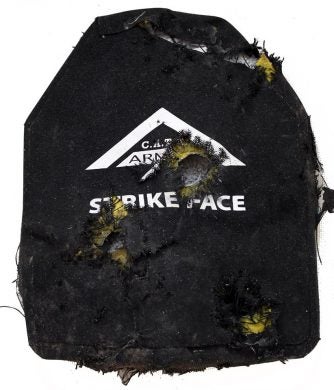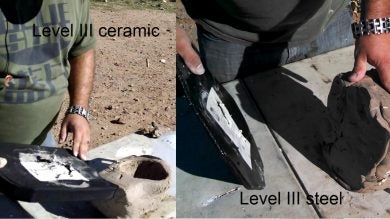Is steel armor worth your money?
Posted by Andrew - The Firearms Blog on Aug 17th 2018
Choosing Body Armor: Is Steel Armor Worth Your Money?
Posted in Other Gear & Gadgets by Andrew with 117 Comments

I recently wrote a couple articles regarding steel armor that may have led some folks to believe that all steel armor is trash. That particular plate is like a stripper: It looks okay, but it’s full of issues. Not all steel armor is garbage, though. As with anything, there are compromises to be made in armor. If you don’t know much about armor, it is tempting to simply purchase armor that has the highest threat level and wash your hands of it. If you know a little bit more about armor, the Dunning-Kruger effect may take hold and you could make some faulty conclusions. Let’s start by dispelling a few common myths.
7.62 > 5.56
NIJ 0101.06 Level III steel armor is rated to stop 7.62x51mm 147 gr FMJ at 2,780 fps. Many folks take that to mean that it can also stop anything “less than” 7.62mm NATO. But level III steel plates are commonly defeated by M193 5.56mm 55 gr FMJ or by higher velocity .223 Rem and 5.56mm ammo such as varmint loads and the 50 gr TSX loaded by Black Hills. Level III UHMWPE plates are commonly defeated by M855 5.56mm 62 gr FMJ. That doesn’t mean either type is garbage, it’s just that they have limits.
Ceramic is Fragile

A CATI ceramic plate that has survived multiple hits with .270 Win, .460 Marlin, .358 Win, 5.56mm, and 7.62x39mm.
Another common myth is that ceramic plates are fragile and will shatter into a million pieces when dropped or that they can only stop one round. It is true that ceramic plates could be damaged with a drop but most are very robust and will continue to protect, even when abused. I hit a Highcom 4SAS7 as hard as I could with a sledgehammer and it was still able to stop multiple rounds of 7.62mm, 5.56mm, and some big bore rifle cartridges. It is also true that it is possible that a hit that lands too close to a previous hit could pass through a ceramic composite plate, but in practice, even rounds that land directly on top of each other are usually stopped. It is also true that steel plates will generally last through hundreds or maybe thousands of hits. Steel is indeed more durable, but ceramic plates are also quite tough. And let’s be honest: if you are hit even a handful of times in your rifle plate, what are the odds that you didn’t take a round to the brachial artery or face? On the other hand, while both will protect you from a rifle hit, the ceramic plate has significant back face deformation, while the steel plate has effectively zero back face deformation. The back face deformation on a plate rated by the NIJ will be within acceptable limits, of course, and it is unlikely to kill you, but it can certainly take some fight out of you.

Back face deformation from a composite plate (L) and steel plate (R)
Steel Plates Will Kill You With Frag
When a bullet hits a steel plate, it splatters into a gazillion (that’s pi raised to the power of a lot) fragments. If those fragments aren’t contained, they can cause a fairly serious injury. They’ll slice right through a plate carrier and clothing. But they don’t penetrate very deeply into tissue. If you were very unlucky, you could catch a piece in the carotid artery, but odds are more likely that it would just be very painful. And that’s why most reputable steel armor manufacturers coat their plates with multiple layers of Paxcon or similar bed liner coating. When properly applied, these coatings will absorb and completely contain the fragments from dozens of rounds.
M193 Kills All Steel Plates
Just as some folks had no idea that M193 can defeat level III steel plates, other folks are starting to become aware of that fact but erroneously apply it to all steel plates. Several makers produce level III+ plates that can stop M193 and other high velocity threats. Now, III+ isn’t an NIJ rating. It really doesn’t mean anything. It’s just an industry term intended to indicate that a plate exceeds the level III standard. Respectable manufacturers apply the III+ “rating” to plates that actually hold an NIJ level III rating as a way of indicating that the plate meets level III standards but is also special threat rated. Several manufacturers make a level III+ plate that will stop Lake City M193 at 20 feet when fired from a 20″ barrel.
Steel Plates Are Heavier
Okay, this one is true. Mostly. Kind of. Level III steel plates tend to be heavier than level III plates made of other materials, but level III composite and UHMWPE plates are also extremely expensive. From a cost perspective, it may be more practical to compare steel plates to level IV ceramic plates. Here, a coated level III+ steel plate is barely heavier. Steel plates are also substantially thinner than ceramic plates and several companies are making dramatic advancements in curved steel plates such as the CATI CQB. That means that the slight weight difference can be outweighed in terms of overall comfort.
Armed with those facts, you can consider which rifle plate best fits your needs. You should consider factors such as threat level, weight, thickness, curve, and of course, price. It may not be a bad idea to look at informal testing such as that performed by Buffman and The Wound Channel as well. While these tests are not scientific, they can give you an idea of what other threats a plate can handle (or not) in addition to its rating. If you haven’t spent a lot of time wearing armor, it might not be a bad idea to borrow a set from a friend and do some yard work in it so you can get a feel for what factors are important for you.
